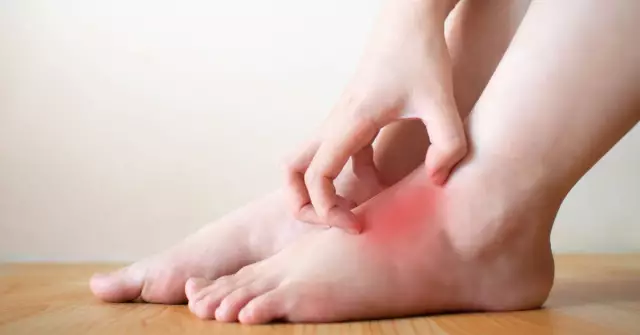- Author Rachel Wainwright [email protected].
- Public 2023-12-15 07:39.
- Last modified 2025-11-02 20:14.
Pyoderma

Of all skin diseases, pyoderma is the most common, in which pustules form on the surface of the skin. This prevalence is explained by the fact that even a healthy person has a large number of pathogens on the skin, which can be activated when the body's defenses are reduced.
Pyoderma is an out-of-season disease, but there is some increase in pustular infections in the autumn-winter period. In countries with hot and humid climates, the disease occurs throughout the year with equal frequency and is second only to fungal skin diseases in prevalence.
The most susceptible to pyoderma are children, people of low social and hygienic culture and workers of those enterprises whose activities are related to the processing of wood, agricultural products, rocks, as well as the transportation of passengers and goods.
Causes of pyoderma
The provoking factors for the development of pyoderma are overheating or cooling, high air humidity, contamination of the skin surface, overwork, stress, damage to the skin of varying severity, diseases of the gastrointestinal tract and metabolism.
With pyoderma, sweat and sebaceous glands, hair follicles are most often affected, but there is also a deeper penetration of the infection, in which boils with one purulent rod or carbuncles with two or more rods develop.
Pyoderma can be acute and chronic, the nature of the course of the disease and its severity depends on the general condition of the body, the depth of the focus of inflammation, as well as the presence of concomitant diseases.
Pyoderma symptoms

The symptoms of pyoderma depend on the localization of the process, the depth and size of the lesion. As a rule, in the place where the inflammation begins, a slight hyperemia appears, in the center of which a yellow dot with purulent contents is noticeable. Soreness and slight itching is noted. The general condition, as a rule, does not suffer, the body temperature is normal. Pyoderma in children is more pronounced due to the fact that the child can unconsciously scratch the places where there are pustules, and the infection spreads throughout the body.
The most noticeable for those around the face is pyoderma, the so-called acne vulgaris, when the inflammatory process captures the sebaceous glands. In the initial stage of the disease, black dots appear on the skin - comedones, in the place of which acne forms as pyoderma develops. Purulent formations can be of different depth and external dimensions. In severe cases of the disease, several acne may merge into one focus of inflammation. Upon recovery, a characteristic smallpox scar remains at the site of the lesion.
If the deeper layers of the skin are affected and a furuncle develops, then the radius of hyperemia increases, and a pustule appears in the center. When it is opened surgically or naturally, a rod is exposed, after which an ulcer remains. With suppuration, pain and a local increase in temperature are noted. With pyoderma of this type, boils can be both single and multiple. After healing, a scar forms at the site of infection.
Also, large pustules are found with pyoderma of hair follicles. Despite the sharp soreness, in folliculitis, in contrast to the boil, there is no purulent core.
The general condition of the body deteriorates significantly with the development of the carbuncle: the body temperature rises, there is a headache, weakness and other signs of intoxication. The patient tries not to make unnecessary movements, as this causes excruciating pain.
Favorite places for such manifestations of pyoderma are the back of the head and back, a little less often suppuration appears on the chest and abdomen. The carbuncle is characterized by the presence of several rods, the removal of which leads to the appearance of an extensive, long-term healing ulcer. At the site of infection, a dense knot of a purplish-cyanotic hue is formed, surrounded by a roller of edematous tissue. Discharged pus of a thick consistency mixed with blood. Recovery ends with the formation of a rough scar.
Pyoderma treatment
Treatment for pyoderma is aimed at improving the body both from the inside and outside.
Local treatment:

It is necessary to provide rational care for the skin. If pyoderma is a localized form, that is, foci of inflammation are isolated, it is not recommended to wash the skin in these places. Whereas with the prevalence of the process, taking general baths is generally prohibited. This is done in order to exclude the transfer of infection to healthy skin.
For the same purpose, the treatment of intact skin around the focus of suppuration is used with a 0.1% aqueous solution of potassium permanganate (potassium permanganate) or 1-2% alcohol solution of salicylic acid.
In those places where there are pustules, antiseptic solutions are used that destroy the pathogen and promote faster healing. The focus of inflammation in pyoderma is treated with an alcoholic solution of brilliant green, Castellani paint, ichthyol ointment or Vishnevsky's ointment. A good effect is given by irradiation with ultraviolet rays. It is undesirable to use an alcohol solution of iodine for the treatment of pyoderma, otherwise the inflammatory process may increase.
General treatment:
In the chronic course of pyoderma, a large area of the lesion, the presence of complications, a worsening of the patient's condition, a course of antibiotic therapy is prescribed. A single dose, the frequency of giving, the method of administration and the duration of the course of taking the medication is determined only by the doctor, self-medication is unacceptable. Before starting treatment for pyoderma, it is required to sow the purulent discharge for the sensitivity of the microorganism to various types of antibiotics.
With intolerance to antibiotics, sulfa drugs are used to treat pyoderma.
As an additional tool, non-specific methods of treatment are successfully used: vitamin therapy, autohemotherapy, administration of immunoglobulins.
Treatment of pyoderma with boils and carbuncles is only surgical, after opening the abscess, the patient is prescribed appropriate therapy. The remaining cicatricial changes can be lubricated with special creams or the services of beauticians can be used.
In children, treatment of pyoderma should be started at the first signs of the disease. Delay threatens not only with the external spread of the infection, but also with its withdrawal inside, which threatens the development of such severe complications as sepsis, osteomyelitis and other diseases.
Prevention of pyoderma
Preventive measures for pyoderma are aimed at observing sanitary and hygienic rules and preventing microtraumas. It is also necessary to carry out timely treatment with antiseptic solutions of the skin when scratches, abrasions and other small wounds appear.
In the presence of chronic diseases of the gastrointestinal tract or metabolism, timely treatment is necessary to prevent relapse.
Prevention of pyoderma in children in infancy consists in monitoring pregnant women in antenatal clinics. Expectant mothers are advised to improve immunity, treat foci of infection in time, and also observe a work and rest regimen.
YouTube video related to the article:
The information is generalized and provided for informational purposes only. At the first sign of illness, see your doctor. Self-medication is hazardous to health!






